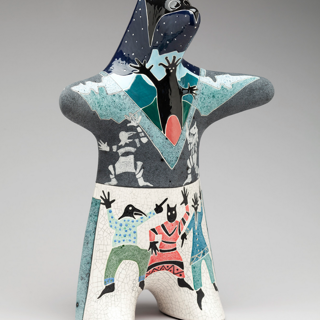Gene Tobey and Rebecca Tobey

As Artists and as parents, Gene and Rebecca Tobey are a breath of fresh air. In today’s formula driven world where people seem to expect one artist per family but not two, Gene & Rebecca Tobey not only work together productively as sculptors but raise their brood of five children, find time to ride horses together and play in the hills and the creek bed near home. Artistic success – growing swiftly and tangibly each year – seems not to have robbed Gene And Rebecca Tobey of the joys of a contemplative and serene life.
They met in 1984 in Santa Fe, NM, coming from separate coasts, separate lives. Growing up in East Tennessee as the daughter of an Oak Ridge scientist, Rebecca Upton’s work was strikingly different from Gene Tobey’s who came of age in the red clay canyons of southeastern Utah. Gene Tobey chose early to make sculptures and teach art. Rebecca left Tennessee for boarding school in Lowell, MA and a professional career in Long Island, NY.
“Rebecca and I had talked about opening a gallery in Santa Fe,” Gene Tobey takes up the tale. “We opened Gallery Five in Santa Fe’s Springer Plaza in 1985, but the oil boom had bottomed out, and there were no Texans, no Oklahomans buying art. Three months later, August 31, 1985, we closed. We were married in November.”
By then, Rebecca was assisting with Gene’s sculptures which evolved from dishes and practical ceramics to stylized animals. “She was my glaze technician,” Tobey explains, meaning the person who applies the glazes before firing. The sculptures in the mid-1980’s were an interesting combination of techniques. Gene Tobey first made a mold of an animal and cut out sections to be superimposed on other parts of the animal. Then, using a steel stylus he engraved designs. Rebecca Tobey did the glazing, imbuing the sculptures with color before the final firing. Over the months, however, Rebecca Tobey encountered problems and slowly began to develop her own techniques and her own ideas about the kind of surfaces that would enhance the three-dimensional qualities of the sculptures.
“In summer of 1987 Gene Tobey had an opening at Preston Gallery,” she recalls, “I wanted to use colored clay slips instead of glazes. Glazes are chemicals that melt and bleed. They don’t have sharp delineations. I wanted a sharp, crisp finish.” Rebecca Tobey coated sections of two sculptures with clay slip. “They were the first in the show to sell,” Gene Tobey says. “We did another one for a show of fourteen pieces in Vail – and again it was the first to sell.” It was magic. “I realized I needed new thoughts and different hands to make different pieces,” Gene Tobey says. Soon Rebecca Tobey worked out not only as a technician but as a part of a creative team. Her role has grown to equal stature, and she and Gene had achieved something together that wouldn’t happen by working alone.
“It’s very exciting to come into the studio and see what she’s done to a piece,” says Gene Tobey. “I’ll look at it and react to it, carrying out her idea in my design.” Generally, when Gene Tobey prepares the pieces for the first or bisque firing, he tapes off certain panels or sections in which Rebecca Tobey paints colors and designing of her choosing. Then Gene creates a matching or supportive design. But who goes first changes daily. Both artists put their individual imprint on each piece of art – together but not at the same time. The excitement they generate in each other shows in the power and originality of the sculptures. “We work independently in the studio,” Gene Tobey says, “because we have commitments with the children and different responsibilities and different things to do in the studio. A lot of times I’ll draw independent of her colors, but if she goes first, then my engravings must echo her designs.”
Once he realized that Rebecca had moved firmly – and permanently – from a technician into an equally creative artist, Gene called his galleries and instructed them to change the credit to “Gene & Rebecca Tobey.” One or two delayed, resisting the idea of naming two people, but now the artistic marriage is etched into each piece. “There are times I don’t like being called an artist because I don’t know the parameters of the term. We’re dealing with our own aesthetic and having fun with it. There’s always something new, and the experiment goes on. I look at Rebecca’s work and feel privileged, not jealous. It’s a blessing when two people work together, not compete but combine. Evolving and changing become our focus. One person takes a step and the other has to take a step to catch up.”
